Ruan, 29: brazilian aquarellist, history major, lover of plants, art and the divine. Umbandista and hellenic polytheist. ig: tioruan / kyprisaquarelas. society6: kypris. redbubble: kyprisaquarelas.
Don't wanna be here? Send us removal request.
Text

Aphrodite by Kypris Aquarelas
#paganism#pagan#polytheism#goddess#god#witchcraft#watercolor#watercolours#magick#hellenismos#hellenic polytheism#hellenic pagan#aphrodite#venus#afrodite#paganismo#deusa#greece#occultism#art#arte#history#artwork#aquarela#love#divine
8 notes
·
View notes
Text

Obatala and Yemaya by Kypris Aquarelas
In Brazil, the yoruba deity Obatala goes by the name Oxalá, a contraction of the expression "Orixalá", meaning "the Great Orisha". In afrobrazilian traditions this Orisha commonly takes two forms: Oxaguian, an youthful and impetuous warrior that likes eating yam and Oxalufan, an old wise man that uses a staff called Opaxorô. The greatest of the yoruba gods, Obatala is an Orisha Funfun (white-wearing deities), he is connected to the Forces of Creation, peace, purity, order and in Brazil it's a common practice to save fridays, his sacred day, avoiding to eat red meat, having intercourse and drinking alcohol. Some of his symbols are the Alá (a white cloth), the igbin (an african snail), the white dove, the Sky and the Sun.
Oxalá is a figure of utmost importance to most of the afrodiasporic religions. His cult is present in religions such as Umbanda, Candomblé, Batuque de Nação, Tambor de Mina, Santeria, Omolokô and many others. He's also syncretized with other proeminente divine figures: the Nkisi (deity) Lembá Dilê worshipped in Bantu Traditions and with Jesus Christ.
One of his most known pontos (prayers) says:
"Oxalá created the Earth,
Oxalá created the Sea,
Oxalá created the World
Where the Orishas reign (...)"
Yemoja, Yemaya or Iemanjá is the name of a major yoruba deity. Her name comes from the expression Yé Yé Omó Ejá: "Mother whose Children are the Fish". Yemaya is an Orisha connected to fertility, maternity, to good mental health and to the sustenance of life. In brazilian lands, she was crowned as the Queen of the Seas, but in reality she's connected to all bodies of water - fresh or sea ones. Her most known symbols are the fishes, the abebé (a fan-like object), sea shells and pearls, the Moon, the colors White, silver and blue. In nigerian lands, she's the goddess of the river Ogun.
Her worship is presente in most of the afrodiasporic religions such as Umbanda, Candomblé, Batuque de Nação, Tambor de Mina, Santeria, Omolokô and many others. Yemaya was syncretized with many catholic saints such as Our Lady of Immaculate Conception, Our Lady of Cabeza, Our Lady of Glory and Our Lady of Navigants. She's also syncretized with other african deities, such as the Nkise Kaiala.
To Yemaya, we sing:
"My brother, when you hear
In the distance a beautiful song,
There must be the Angels from Paradise
or the Mermaid of the Sea..."
#paganism#pagan#polytheism#watercolor#watercolours#yemaya#iemanjá#oxalá#obatala#orisha#orixá#politeísmo#black art#nkise#africa#african#folk catholicism#goddess#god#jesuschrist#Oxaguian#witchcraft#magick#kaiala#lemba#lembadile#jesus#our lady#mermaid
17 notes
·
View notes
Text

Yemaya by Kypris Aquarelas
#yemaya#watercolours#oil painting#oil on canvas#polytheism#art#witchcraft#illustration#painting#brazil#umbanda#occult#brasil#witch#hoodoo#voodoo#lasirena#la sirena#Iemanjá#yemoja#cty#candomblé#orisha#orixá#mikaya#mikaia#ndandalunda#goddess#deity#oricha
143 notes
·
View notes
Text

Exú by Kypris Aquarelas
"O garfo de Exu é firme A capa de Exu me rodeia Passei pela encruzilhada Exu não bambeia..." 🔱✨
Os Exús cultuados em tradições afroameríndias são espíritos-entidades-guias-bakuros que compõem o Povo Encantado da Rua. Tal qual as Pombogiras, são ancestrais que estabeleceram relações com as encruzilhadas, os caminhos, as ruas, as almas, são senhores da noite, amigos íntimos do luar e da magia.
O nome Exú vem de uma divindade muito conhecida por todos os iniciados em tradições afroameríndias e muito controversa aos olhos de quem não o reconhece. Dito por alguns como o Orixá mais humano, ele é senhor dos inícios, das transformações, é o dono do mercado, fala todas as línguas e tem um papel importante na conexão e comunicação entre Orum (Céu) e o Ayê (Terra), além de entre os humanos e os Orixás. Seu nome, "Exú", significa "esfera", alguns mitos relatam que ele foi a primeira divindade criada por Olodumare, o Ser Supremo.
Embora sejam seres diferentes, Exú Orixá e Exús entidades compartilham as estradas, os caminhos, a ligação com o fogo, com a magia, com a sensualidade e também recebem suas honrarias no início das ritualísticas das tradições de matriz africana onde são cultuados.
_________________________________________________________
The Exús (or Eshu) worshipped in afrodiasporic religions like Umbanda and Candomblé are a kind of ancestors or spirit guides. Just like the Pombogiras, they're ancestors connected with the crossroads, the pathways, the streets, they act like psychopomps, they're masters of the night, close friends of the moonlight and magick.
The name Exú (or Eshu) comes from a namesake well-known deity, the Orisha (deity) Eshu. To those who don't know him well, he's seen as a controversial character. Said by some as the most human Orisha, Eshu is the god of the beginnings, of transformations, he's the owner of the market, speaks every language in the world and has an important role in the connection and communication between the Orum (Spiritual World) and the Ayê (Physical World), and also between humans and gods. His name, Eshu, means "sphere", some myths depict him as the first deity created by Olodumare, the Supreme Being.
Although they're different beings, Orisha Eshu and spirit-guides Eshus share as symbols the pathways, the roads, their connection with the element fire, with magick and witchcraft and sexuality. Their roles in the ritualistics of afrodiasporic traditions are similar, receiving always worship and cult before anyone else.
"Exu's fork is steady Exu's cloak surrounds me I went through the crossroads Exu doesn't wobble…" 🔱✨
#aquarela#watercolor#watercolour#aquarelle#exu#eshu#moon#umbanda#candomblé#artwork#art#arte#illustration#ilustração#orixás#orishas#night#noite#lua#afrobrazilian#painting#pintura#laroye#watercolours#polytheism#witchcraft#witchy#santeria#voodoo#hoodoo
29 notes
·
View notes
Text
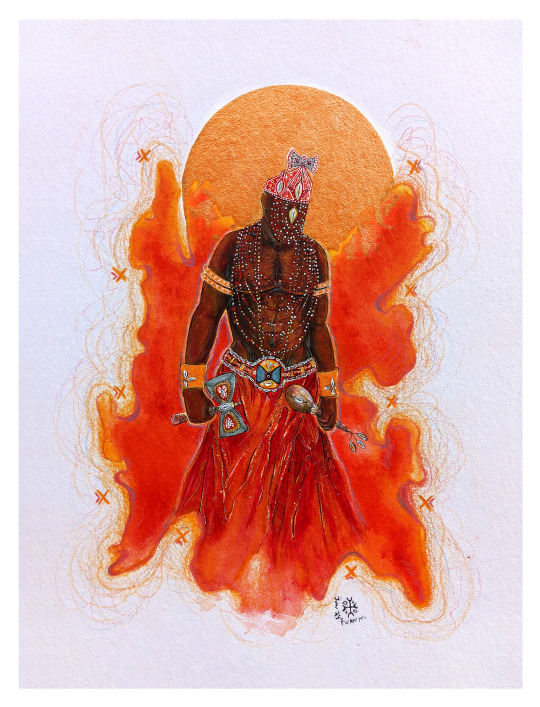
Xangô Aganjú by Kypris Aquarelas
Xangô e Aganjú são dois Orixás que estão fortemente associados tanto em terras africanas quanto na diáspora brasileira. Da família de pai Xangô, figurando entre sobrinho, primo ou até pai de Xangô, ambos são Orixás que foram alafins (título que significa "Senhor do Palácio") do império de Oyó, são simbolizados pelos oxés (machados duplos), pelas cores vermelha, marrom e branco, estão relacionados aos raios, trovões e ao fogo. Segundo os antigos, ele é o Orixá da força, dos vulcões, da lava em chamas que emerge das profundezas da terra, muitas vezes visto como um "Xangô Menino".
Com a realidade imposta pela diáspora, o culto de Xangô e de Aganjú, em muitas tradições, sofreu uma aglutinação, dando origem ao famoso "Xangô Aganjú". Ele é cultuado em religiões afrolatinas como os Candomblés, as Umbandas, nos Batuques de Nação, na Santeria cubana onde é sincretizado com São Cristóvão, entre outras.
"Estava olhando a pedreira
Uma pedra rolou, ela veio
Rolando e bateu em meus pés
E se fez uma flor
Quem foi que disse
Que eu não sou filho de Xangô?
Ele mostra a verdade,
Se atira um pedra
Ela vira uma flor.."
Que pai Xangô e Aganjú, Sogbô, Zambará e Nzazi transformem todas as pedras nos nossos caminhos em lírios!
_______________________________________
Shango and Aganju are strongly associated Orishas, both in African yoruba lands and in the Brazilian diaspora. Belonging to Shango's family, Aganju sometimes is depicted as his nephew, cousin or even his father, but both were once alafim (a title which means "Lord of the Palace") of the Oyo empire. As some of their symbols, the oxés (double axes), along with the colours red, brown and white, the element fire, lightnings and thunders are numbered. It's said that Aganju is the Orisha of strenght, vulcans and of the burning lava that emerges from the depths of the earth. He's commonly seen as a "Xangô Menino" (young Shango).
As the reality imposed by the diaspora developted, the cult and worship of Shango and Aganju in many traditions suffered an agluttination, giving rise to the cult of "Shango Aganju". He's worshipped in many afrodiasporic traditions such as Candomblé, Umbanda, Batuque de Nação, in the Cuban Santeria where he's sincretized with Saint Christopher.
May pai Shango, Aganjú, Sogbo, Zambará and Nzazi all turns the stones in our way into lilies!
#polytheism#art#witchcraft#illustration#witch#painting#occult#brazil#umbanda#brasil#candomble#orisha#orixá#orixas#nzazi#shang#shango#xangô#politeísmo#batuque#sogbo#zambará#africa#african deities#african deity#watercolor#watercolour#watercolours#aquarelle#aquarela
26 notes
·
View notes
Text

Feline by Kypris Aquarelas
#watercolour#watercolours#watercolor#aquarela#art#illustration#painting#brazil#brasil#ilustração#pintura#guepardo#feline#big cat#cat#felino#wild life#Spirit animal
1 note
·
View note
Text

Witch-doctor by Kypris Aquarelas
#watercolours#watercolour#watercolor#aquarela#aquarelle#illustration#art#arte#painting#pintura#ilustração#male#male body#male body art#male beauty#loboguará#brasil#brazil#mystic#occult#occultism#witch#witchcraft
15 notes
·
View notes
Text

Caboclo das Matas by Kypris Aquarelas
Os Caboclos são os espíritos ancestrais donos dessa terra gigante que chamamos de Brasil. Compõem um dos pilares de religiões brasileiras como a Umbanda onde recebem seu devido culto e respeito. Os Caboclos são filhos de Oxóssi, o Caçador de Uma Flecha Só, são um povo ligeiro, tenaz, conhecidos por ter fortes brados, são sábios e corajosos, alguns usam cocares, arco-e-flecha, bodoques e também fazem o uso das ervas e do cachimbo sagrado para abençoar o caminho de quem recorre ao seu axé.
"A mata estava escura Um anjo iluminou No centro da mata virgem Foi Seu Oxóssi quem chegou Mas ele é o rei, ele é o rei, ele é o rei Mas ele é o rei de Aruanda, ele é o rei" 🌿🏹✨
Saravá o Caboclo das Matas! 🌿🏹✨
____________________________________
The Caboclos are the ancestral spirits of the indigenous people that owned the land where Brazil is located. They're one of the main pillars of afrobrazilian religions such as Umbanda and Jurema Sagrada, where they receive their due worship and respect.
The Caboclos are the children of the Orisha Oxossi, the One-Arrowed Hunter. They'are a tenacious, corageous, wise, swift and powerful kind of spirit guide with their strong war-cries. In the terreiros (Umbanda's temples), some of them use headdresses, bow and arrows, bodoques and also make spiritual and medicinal use of sacred herbs such as rosemary, sage, snake-plants, tobacco, fern and the smoke from the tobacco pipes to purify and bless the path of those who seek their help.
The word Caboclo comes from word of the tupi language "caa-boc" which means "the one who comes from the forest".
#watercolours#watercolor#watercolour#umbanda#caboclo#jurema sagrada#polytheism#aquarela#arte#art#painting#illustration#ilustração#candomblé#politeísmo#afrobrasileiro#brasil#brazil#amazon#native#indigenous#indígena#povos indígenas#caboclos#caboclo das matas#oxóssi#orixá#orisha#orishas#orixás
24 notes
·
View notes
Text

Pombagira by Kypris Aquarelas 🔱
Pombagiras are one kind of ancestors or spirit guides present in afrobrazilian religions like Umbanda and Candomblé. They represent and are the spirits of women, especially those who were persecuted and often forced to recede into the margins of society.
They are the strong wind that comes down the mountains, the ancestral spirits who own the crossroads, the pathways, queens of the souls, ladies of the night and magic.
Pombagiras are Ngangas, Pombagiras are Exú-Mulher! 🔱
As for the word "pombagira", also written as pombogira, bombojira, pombajira and in many other ways, it's probably a corruption of "Pambu Njila", one of the Nkise (deities) of the Bantu people (Congo/Angola) similar to the Orixá Exú. Pambu Njila is worshiped in Brazil in the Candomblé Angola as the deity of pathways and crossroads, he is the intermediary between human beings and the Minkise (deities). Over time, in Brazilian lands, these ancestral spirit guides gained the name Pombagiras, as they share the streets, paths, sexuality and crossroads as areas of activity with the Nkise Pambu Njila.
_____________________
Pombagiras são um tipo de ancestrais ou espíritos guia presentes em afroreligiões como Umbanda e Candomblé. Elas representam e são os espíritos de mulheres, principalmente aquelas que foram perseguidas e forçadas às margens da sociedade.
Elas que são a ventania que vem descendo a serra, espíritos ancestrais donas das encruzas, dos caminhos, rainha das almas, senhoras da noite e da magia.
Pombogira é Maria, é Padilha, é Quitéria, é da Kalunga, é Mulambo, é Cigana, é Dama da Noite, é das Setes Encruzilhadas, é Rosa Encarnada, é da Praia, é das Sete Saias.
Pombagira é Nganga, Pombagira é Exú-Mulher! 🔱
"Ela gira no ar, ela gira na praça, ela gira na rua Ê ê ê Ela canta, ela dança, ela vive sorrindo em noite de lua Ê ê ê Ela é sincera, ela é de verdade Mas cuidado amigo que ela não gosta de falsidade"
A palavra "pombagira", também escrita como pombogira, bombojira, pombajira e de tantas outras formas, é provavelmente uma corruptela de "Pambu Njila", um dos Nkise (divindade) do povo bantu (Congo/Angola) semelhante ao Orixá Exú. Pambu Njila é cultuado no Brasil no Candomblé de Angola como senhor dos caminhos e das encruzas, é o intermediário entre o ser humano e os Minkise (divindades). Com o passar do tempo, em terras brasileiras, esses espíritos-ancestrais-guias ganharam o nome de Pombagiras, já que compartilham com o Nkise as ruas, os caminhos, a sexualidade e as encruzilhadas como áreas de atuação.
#watercolours#watercolor#arte#aquarelle#art#illustration#religion#umbanda#candomblé#folk catholicism#terecô#spirit guide#exu#eshu#pombogira#pombagira#pambu njila#orixá#nkise#nkisi#orisha#afrobrazilian#afrobrasileiro#paganism#witchcraft#witch#witches#witchcore#magick#magic
38 notes
·
View notes
Text

Preto Velho by Kypris Aquarelas
Pretos and Pretas Velhas are one kind of ancestors or spirit guides present in afrobrazilian religions like Umbanda and Candomblé. They represent and are the spirits of enslaved ancestors of black people in Brazil. They enjoy working with candles, wine, mpemba, coffee, medicinal herbs and whatnot to bless and remove evil spells from the believers. Most of them are quite kind and calm, but don't be mistaken: they're very wise, powerful and mandingueiros.
#umbanda#preto velho#preta velha#orixá#orisha#oricha#oxalá#oxala#candomblé#brazil#brasil#religion#spirituality#magic#spirit guide#ancestor#ancestor worship#ancestors#slavery#watercolor#watercolour#aquarelle#watercolours#painting#paint#illustration#ilustração
9 notes
·
View notes
Text
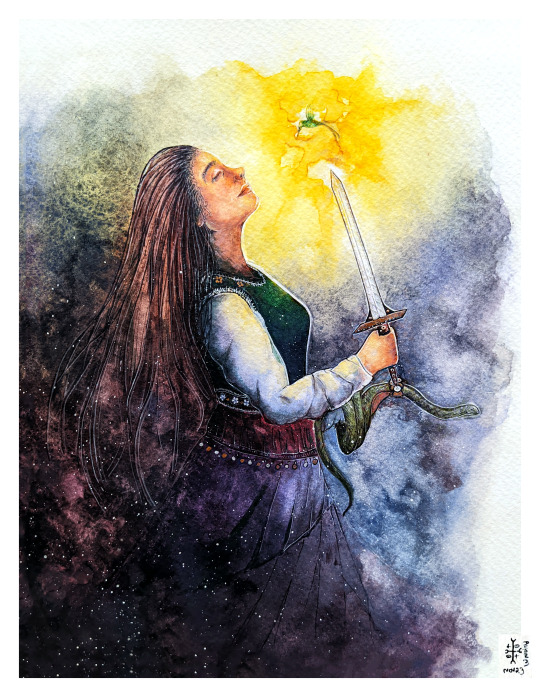
She-warrior by Kypris Aquarelas
#watercolours#watercolor#aquarelle#aquarela#illustration#ilustração#drawing#art#arte#paint#painting#fantasy#fantasia
7 notes
·
View notes
Text
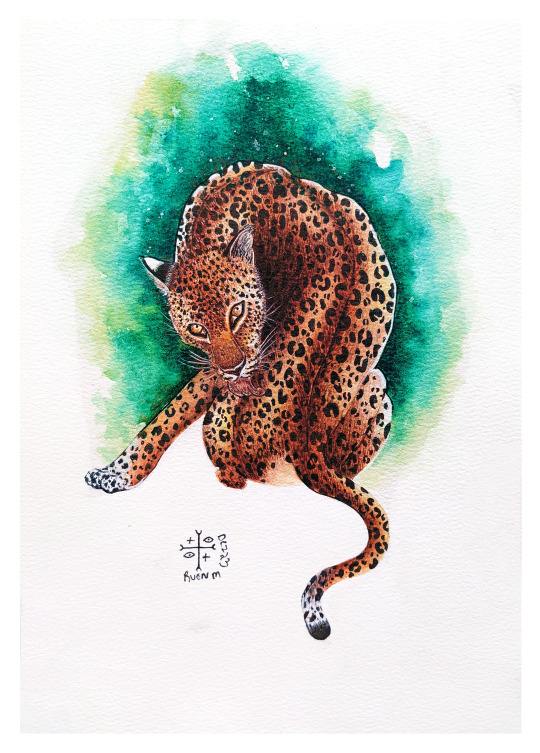
Jaguar by Kypris Aquarelas
#watercolours#watercolor#aquarelle#art#arte#painting#amazon#amazonia#illustration#ilustração#jaguar#onça#brasil#brazil#feline#felino
36 notes
·
View notes
Text
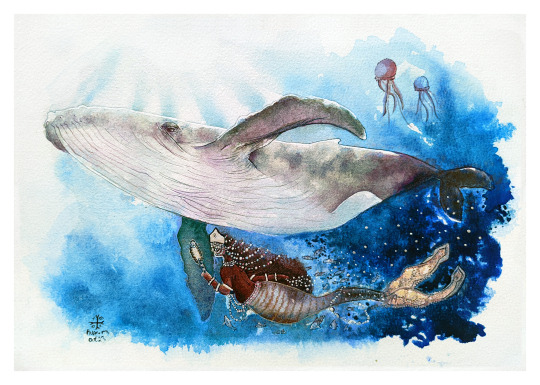
Yemaya by Kypris Aquarelas
#watercolours#watercolor#watercolour#aquarelle#aquarela#drawing#inktober#ilustração#deusa#baleia#whale#sea#mar#ocean#orisha#orisa#orixá#orixa#candomblé#umbanda#iemanjá#yemaya#yemanjá#iemanja#yemoja#samba#brazil#brasil#yoruba#bantu
13 notes
·
View notes
Text

Nanã and Shangô by Kypris Aquarelas
Prints available at society6!
______________________________________________________________
Nanã é uma orixá tida como Mãe Antiga, chamada carinhosamente pelos adeptos de religiões de axé como a Avó. Tem conexão com a ancestralidade, os pântanos, os poços, o fundo do lago, a vida e a morte, a saúde, maternidade - a terra, a água, o lodo estão sob seu olhar. Carrega consigo o ibiri, um bastão de hastes de palmeira. Nanã é mãe de orixás como Iroko, Oxumaré e Obaluayê, a quem abandonou devido ter nascido com feridas pelo corpo. Deusa dos mistérios, nas palavras de Serena Assumpção, Nanã Buruquê "nas matas é água benta / nos rios é flecha ligeira", dos seus filhos e filhas se canta que "quem anda com Mamãe, anda bem devagarinho / quem caminha com Mamãe, nunca fica no caminho". Nanã foi sincretizada com Nossa Senhora Sant'Anna no Brasil, uma das suas saudações mais conhecidas é "Saluba, Nanã".
"Quando chega na beira da costa, salve a Lua, salve o Sol, Quando chega na beira da costa, salve Nanã que é nossa Vó!" (Omolu, cordeiro de Nanã - Águas de Aruanda)
Por outro lado, Xangô é rei dos reis, orixá da justiça, do poder, da realeza, dos trovões e do fogo, do calor da lava dos vulcões que são o "corpo vivo de Xangô", segundo Bethânia. Conta-se que Xangô foi um dos mais conhecidos e poderosos alafins de Òyó, antigo e poderoso império da África Ocidental. Xangô carrega seus oxés, machados duplos, tem sua morada terrena nas pedreiras e sua saudação mais conhecida é "Kaô Kabiesilê". No Brasil é sincretizado com São Jerônimo.
"Obá é meu rei É pai Xangô É justiceiro Nagô Kabiesilê Xangô é rei na cachoeira Xangô é chefe na pedreira" (Xangô - Serena Assumpção)
#aquarela#watercolor#watercolour#aquarelle#nanã#nanan#xangô#sango#umbanda#candomblé#artwork#art#illustration#ilustração#orixás#orishas#deusa#shango#nanburuque#buruku#painting#pintura#watercolours#arte#pagan#paganism#polytheism
37 notes
·
View notes
Text
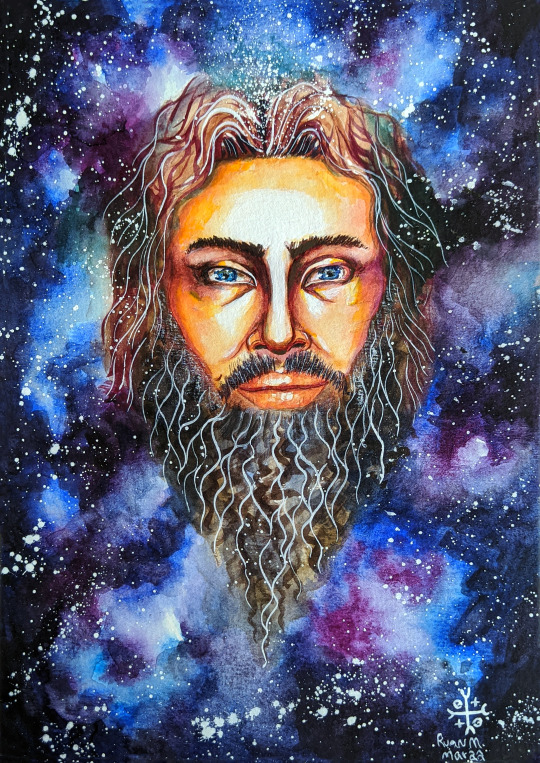
Cosmic Zeus by Kypris Aquarelas
Prints available at society6!
#theoi#paganism#pagan#polytheism#goddess#hellenismos#god#deity#art#hellenic polytheism#zeus#zefs#dios#dias#jupiter#iuppiter#roman#greek god#greek mythology#greek myths#myths#greek myth#watercolours#watercolor#aquarela#portrait#illustration#ilustração#universe#cosmos
18 notes
·
View notes
Text
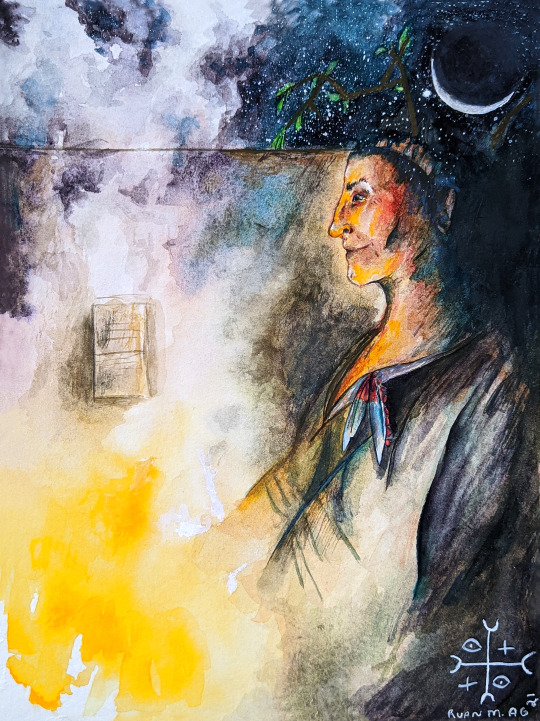
Shaman by Kypris Aquarelas
Prints available here at society6!
#shaman#watercolours#watercolor#aquarela#art#arte#painting#pintura#ilustração#illustration#brazilian artists#brazilian art#amazon#amazônia#native american#nativo americano#indigenous#indígena#cacique#pajé#witchdoctor#xamã#ayahuasca#peyote#medicine man
2 notes
·
View notes
Text

Scorpio Moon by Kypris Aquarelas
Prints available here at society6!
#scorpio#scorpio moon#zodiac#zodiac sign#sign#spirituality#suspiria#escorpião#watercolour#watercolor#watercolours#aquarela#illustration#art#surrealism#surrealismo#macabre#macabre art#dark art
0 notes